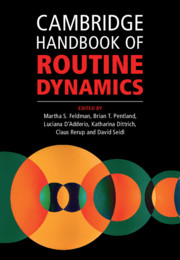Book contents
- Cambridge Handbook of Routine Dynamics
- Cambridge Handbook of Routine Dynamics
- Copyright page
- Contents
- Figures
- Tables
- Contributors
- Preface
- Chapter 1 What Is Routine Dynamics?
- Part I Theoretical Resources for Routine Dynamics Research
- Part II Methodological Issues in Routine Dynamics Research
- Part III Themes in Routine Dynamics Research
- Part IV Related Communities of Thought
- Author Index
- Subject Index
- References
Chapter 1 - What Is Routine Dynamics?
Published online by Cambridge University Press: 11 December 2021
- Cambridge Handbook of Routine Dynamics
- Cambridge Handbook of Routine Dynamics
- Copyright page
- Contents
- Figures
- Tables
- Contributors
- Preface
- Chapter 1 What Is Routine Dynamics?
- Part I Theoretical Resources for Routine Dynamics Research
- Part II Methodological Issues in Routine Dynamics Research
- Part III Themes in Routine Dynamics Research
- Part IV Related Communities of Thought
- Author Index
- Subject Index
- References
Summary
This chapter offers an introduction to Routine Dynamics as a particular approach to studying organizational phenomena. We provide a brief description of the genealogy of research on routines; starting with the work of the management scholar Fredrick Taylor (1911) and the pragmatist philosopher John Dewey (1922) at the beginning of the last century, to the works of the Carnegie School on standard operating procedures around the middle of the last century, to the economics-based Capabilities approach and finally the practice-based approach of Routine Dynamics around the turn of the century. We also discuss the advantages of conceptualizing patterns of action as “routines”, as compared to “practices”, “processes”, “activities” or “institutions”. In particular, we highlight that the concept of routines directs the researcher’s attention to certain specificities of particular action patterns, such as task orientation, sequentiality of actions, recurrence and familiarity as well as attempts at reflexive regulation. We also introduce and explain the key concepts of the Routine Dynamics perspective and how they have developed over time.
- Type
- Chapter
- Information
- Cambridge Handbook of Routine Dynamics , pp. 1 - 18Publisher: Cambridge University PressPrint publication year: 2021
References
- 9
- Cited by



